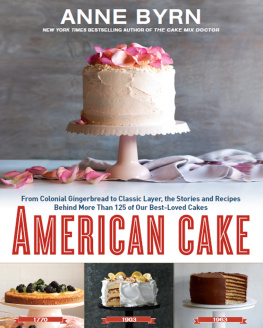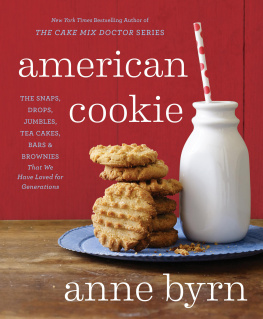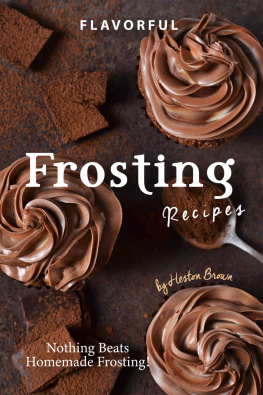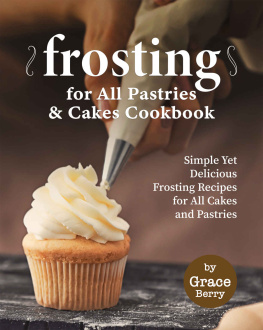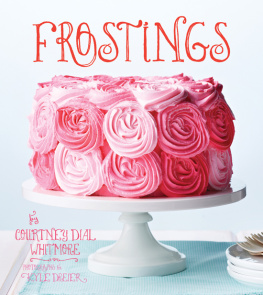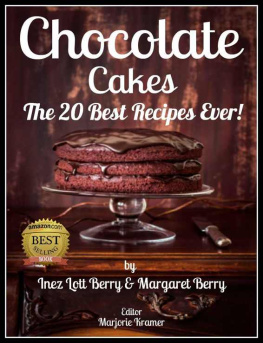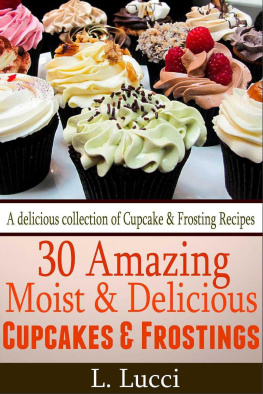The Cake Mix Doctors
ICING ON THE CAKE
30 Fabulous Frostings and Glorious Glazes, Icings,
Drizzles, and One Perfect Ganache
BY ANNE BYRN

Copyright 2011 by Anne Byrn
The Cake Mix Doctor is a registered trademark of Anne Byrn.
All rights reserved. No portion of this book may be reproducedmechanically, electronically, or by any other means, including photocopyingwithout written permission of the publisher. Published simultaneously in Canada by Thomas Allen & Son Limited.
The Cake Mix Doctors Icing on the Cake is a compilation of selected recipes previously published in The Cake Mix Doctor , Cupcakes from the Cake Mix Doctor , The Cake Mix Doctor Returns , and The Cake Mix Doctor Bakes Gluten-Free .
ISBN: 978-0-7611-6562-0
Cover photo by Gabrielle Revere
Workman books are available at special discounts when purchased in bulk for premiums and sales promotions as well as for fund-raising or educational use. Special editions or book excerpts can also be created to specification. For details, contact the Special Sales Director at the address below or send an e-mail to specialmarkets@workman.com.
Workman Publishing Company, Inc.
225 Varick Street
New York, NY 10014-4381
www.workman.com
CONTENTS
CRAZY ABOUT FROSTINGS
Cake may be my calling, but frosting is my passion. Be it a creamy chocolate buttercream, a tangy citrus glaze, or a spoonful of warm caramel icing that cascades down the side of a cake, frosting is the final touch in the kitchen and makes the first impression on the table. The curvy swirls on top of a chocolate cake or the elongated strokes around the side of a luscious lemon layer cake are beautiful to the eye. Frosting enrobes a cake in flavor and also keeps it moist for days. And of course, the great taste of frostings helps make cakes memorable.
Even when I was young and not tall enough to reach the mixing bowl without climbing onto a stool, I somehow managed to sneak a taste of my moms chocolate frosting. It was the kind of frosting she made on top of the stove by melting butter and stirring in cocoa, then adding milk and enough confectioners sugar to pull the frosting together into a sleek and wonderful fudgelike consistency we craved. Frosting was and forever will be a memory maker for me. It dresses up any cake, whether the cake begins with a mix or is made from scratch.
Welcome to my book of frostings. While I included frostings in each of my previous books, they were placed at the back. Not here. Now frostings have their own book, a time to really shine.
The frostings and glazes in this book fall into two groups: cooked and uncooked. The cooked frostings include pan frostings of chocolate, caramel, penuche, and marshmallow creme. I suppose ganache is also a cooked frosting because you quickly bring cream to a boil, pour it over chopped chocolate, and stir it with a wooden spoon until smooth. But its one easy cooked frosting, a breeze to prepare.
Most of my frostings are uncooked, buttercreams or cream cheese frostings or quick glazes. Theyre fast and reliable any time of the year. Plus, uncooked frostings are a snap to make the day before you need to frost a birthday cake or the sea of cupcakes for your childs class party. Just bring the bowl of frosting to room temperature to make spreading easier.
Enough talk! Lets get baking cakes and making frosting to spread on cakes of all kinds. As you slather on buttercream and spoon over speedy glazes, dont be surprised if frosting becomes your passion, too.
Happy frosting!
Anne Byrn
FROSTING 101
Even if you bake a cake using a mix, there is absolutely no reason not to make the frosting yourself as it is quite easy. Heres how to prepare cakes for frosting, make better frosting than anything you can buy at the supermarket, frost layer cakes beautifully, and present them with style.
I. Cooling the Cake
Lets say your cake is in the oven. To check to make sure its done, lightly press the top of the cake. If it springs back its signaling the cake is done. Once out of the oven cakes need to rest somewhere cool before being inverted out of the pan and onto a rack to cool completely. You can place the cake pan on a wire rack, the grate of your stove, or on a granite countertop. Layer cakes should cool for five to ten minutes in the pan. Any longer than that and the cake layers may stick to the pan. Any shorter time than that and the hot cakes may split. If youve made a Bundt or tube cake, or a 13 by 9inch sheet cake you want to remove from the pan before frosting, youll need to let it rest for 15 to 20 minutes in the pan.
To remove a cake from its pan, run a dinner knife around the edge to loosen it. Holding the pan with hot pads, carefully shake the cake then turn it over onto a wire rack. Cake layers need to be inverted twice if you plan to stack and frost them. Thats because if you let the cake rest with the top side down on the rack, lines will form as the cake cools and when you remove the cake from the rack, the entire top may come off. Invert tube cakes twice, too, so that the fuller top side is up. A Bundt cake, however, needs just one flip onto a rack to cool; its fluted top is what you want to see on the serving platter.
Let cakes cool completely before frosting them. For layers this will be about 15 minutes longer, for Bundts and tubes about 25 minutes, and for sheet cakes, somewhere in between. Pastry chefs speed up the cooling process by placing cake layers in the refrigerator, and this does cut the cooling time in half should you be in a hurry. If you need to delay frosting the cake layers for more than an hour after they have been placed on a rack to cool, cover the cooled cakes with the pans they were baked in or with a piece of waxed paper or a light kitchen towel so that they dont dry out.
Frosting vs. Icing
Whats the right termfrosting or icing? For continuity in this book, I have labeled all the frostings and what might be called icings, simply as frostings. And the verb of choice is to frost a cake. But it does make you wonder
In Southern Cooking, written by Henrietta Dull of Atlanta in 1928, she lists only one frosting, a mocha, but more than a dozen icings. In my 1943 edition of The Joy of Cooking, all the cake toppings are called icings, from white to chocolate to caramel to marshmallow. Now the exception to the rule seems to be royal icing, and I havent found a royal frosting yet. Frosting may be the word of choice today, but icing has a nice old-fashioned ring to it, just like the icebox, the forerunner of the refrigerator.
II. Frosting the Cake
There is no right or wrong frosting or glaze for a cake. Use your preference to select something that will complement what you have baked. As a general rule, however, caramel frostings and other frostings that set up firmly are best with softer-textured cakes. Fluffier icings like cream cheese or buttercream go better with dense cakes. You might want to play up corresponding flavors in cakes and frostings. For example, serve a maple frosting with a spice cake or a peppermint frosting with a chocolate cake. But these are only my suggestions. Feel free to try the frostings on any of your favorite cakes.
10 Steps to a Frosted Layer Cake
No worries! Frosting a cake is fun. It is also something that you get better at with practice. So here are my tips to get you started.


